Why the expense, and why Alpina?
In 2014 just before I shot off on my September tour from the Isle of Man to Almeria via Irelands Wild Atlantic Way and the Pyrenees I decided replace the wheels on my F800GSA for the Alpina Tubeless Wheelset.
This rather costly expense raised more than a few eyebrows, some folk thought I now must have more money than sense. I shall let you decide, but first I’ll ask a few questions and tell a short tail of worry and woe in the high Pyrenees.
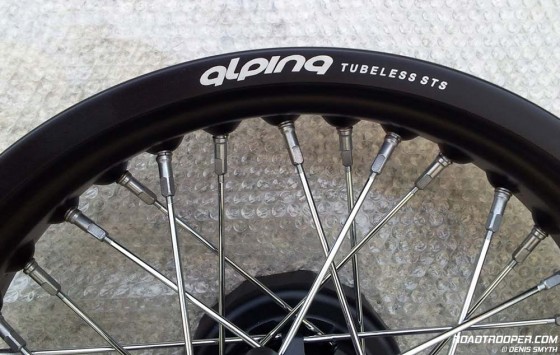
Alpina STS Tubeless front wheel for the F800GS/A
Why is it that any time I’ve ever had a puncture it also been cold, wet and miserable?
… It’s it Sods Law, Murphy’s Law or the fact that rain washes debris onto the road in front of my tyre? Is it because water acts as a lubricant and, as we all know lube makes it easier to drive large pointy things things into small holes?
… Is it because sharp objects are more likely to stick to a wet tyre and work themselves through the rubber?
… Is it because a tyre has less friction in the wet which makes it easier for an object to push through to deflate my tire, or is it the opposite??
… Is it because it’s easier to cut rubber if it and the knife are wet? And why have I only ever had a flat on the rear wheel and never the front?
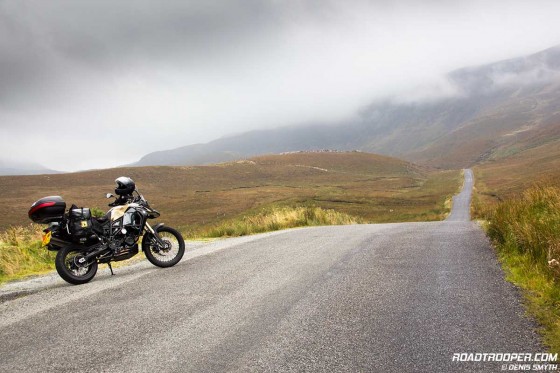
Sept 2014 on Irelands Wild Atlantic Way.
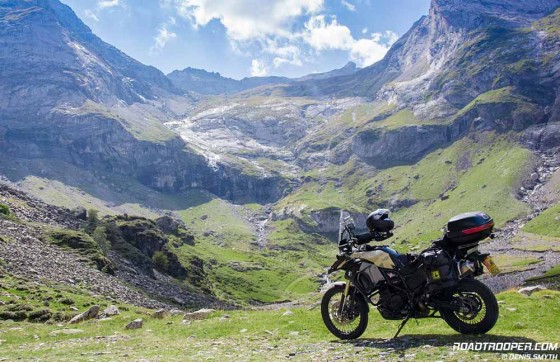
Pyrenees, Sept 2014. It’s hard to beat trail riding in the Pyrenees!
All these questions and more were rattling through my brain box as I rode along a remote road in the Basque Pyrenees in sub-zero temperatures whilst being pounded by hail, sleet and misery on the 19th of May 2013.
I was disturbingly aware I had an almost sheer drop of a few hundred feet to my right, not that I could see it as I was deep in cloud, my visor was terminally fogged over and it was getting dark. I had managed to ride myself into the worst Atlantic storm I’ve yet to experience in 24 years of riding motorbikes and I’d made a massive mistake, I should have called it quits hours ago and found a hotel. Instead I was wet, hungry, bitterly cold and to make it worse, somewhere along the previous 9 hours of torrential rain my SatNav had died a pitiful death and I only had a vague idea of where I was.
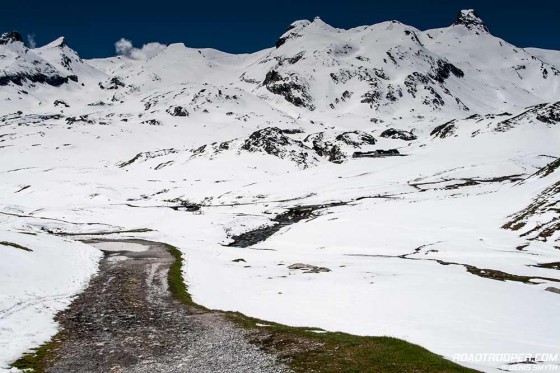
Pyrenees, May 20th, 2013. The storm cleared up next day, but it was bitterly cold and many of the passes were snow bound and made for some “interesting” riding ![]()
Over the last 14 years of riding the Alps I’d developed a rule of thumb. If it’s cold, wet and windy at 500 meters it’s likely far worse and snowing at 1200 meters so always take the low road. Thanking to my SatNavs demise I’d taken a wrong turn outside Saint-Jean-Pied-de-Port and I was now on a one track at around 1400 meters, not good. Luckily I had not been completely stupid, I’d packed an ample supply of high energy bars, nuts and dried fruit and a small compass which eventually found me heading true to the village I was seaking. These were about the only things I’d remembered to bring from a mountain survival course I’d done 10 years previous.
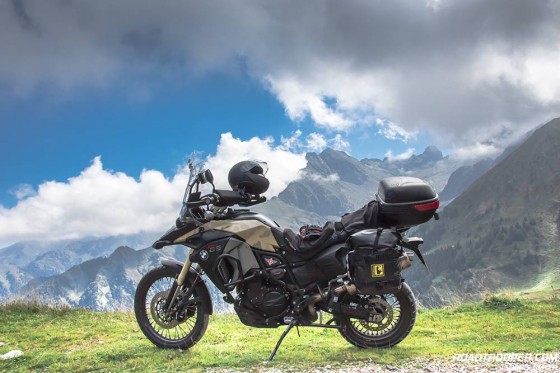
Boys toy’s in the high Pyrenees ![]()
Now that you know where I was as I was thinking, if I get a puncture up on the mountain now, in this weather, and in my current state I am well and truly royally fucked! I was at least 15 miles from the nearest house, there was no phone signal up there and my BMW Rallye 3 suit was sodden, unbearably heavy, leaking and lending me the look of a derelict bum. If I’d had a puncture I’d have no easy options. Whats the big deal, if you get a flat just plug it and move on you may ask?
The big problem was that I was riding a BMW F800GS with spoked wheels and therefore a tubed tyre. My hands were frozen, it was rapidly getting darker, the temperature was still dropping, the sleet had turned to snow and was sticking. I was absolutely in no condition to start disassembling the bike now. Nor did I have the time before the roads got too icy to ride, in the space of the previous hour the temperature had plummeted from 0C to -9C. The exact same area the previous May had seen me riding in +20C, it was now looking more like the location for the Elephant Rally and I was not prepared for this.
Tubes vs. Tubeless Tyres
Bastard tubed tyres! I mean seriously why on earth can’t BMW figure out how to sort out a tubeless spoked wheel for the F800GS? To get a puncture now I’d have a lot of work ahead of me to unload all the tools necessary, pull off the wheel, then the tyre, replace the tube and reverse the process. Mr. BMW, or anyone else that tells me different, let me tell you this, repairing a puncture on a tubed tyre is a pain in the arse at the best of times, but on that mountain and in that weather a puncture would have had the same result as a catastrophic engine failure or running out of fuel. I’d be walking!
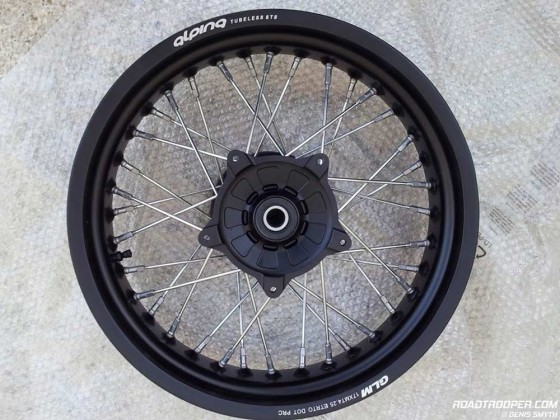
The Alpina STS 21″ Tubless Wheel for the F800GS and F800GS Adventure
Thankfully of course I did not get a flat. But it got me to thinking. Yes, I can repair a flat in the comfort of my garage, or if I had too, out on the dirt trails of the Spanish desserts I love so much. But I now know I could not do it on a dark lonely mountain in freezing temperatures. I also doubt that I could do it on the side of many roads or motorways, at night and in the rain without having a car or truck turning me into a messy red meaty streak along the asphalt. I also spend a fair amount of time on Spanish motorways where fixing or replacing a tube is absolutely not possible, and in fact illegal as much of the motorways around Alicante, Barcelona etc have no hard shoulder. If you breakdown here the Guardia Civil show up very quickly, if you can’t fix you problem in short order it’s a tow truck plain and simple.
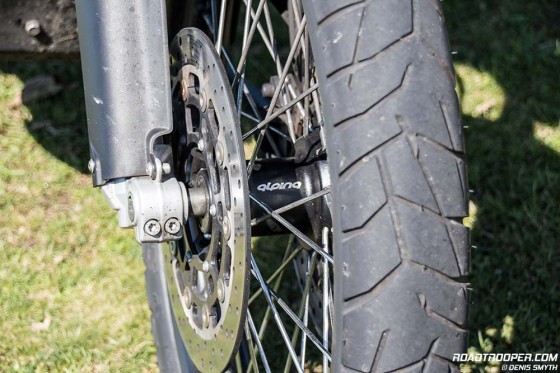
Alpina STS on the F800GSA
Up until recently off-road, classic bike, and MX riders have hassled with the inner tubes inside their spoked rims, while the vast majority of road bikes have switched over to hollow cast wheels that allow a tubeless tire to be used. But where a tubed tyre can be “most often” plugged and reinflated in under 10 minutes a tubed tyre is a very different ball game. Fixing or replacing a tubed tyre is not really a big deal, but it takes time (less with practice), specific tools and the opportunity to do it safely – off the road and away from other traffic.
The reason spoked wheels are used for off-road bikes is that the spoked design allows a certain amount of flex to help absorb impacts that would fracture one-piece wheels, and if the rider breaks a spoke or two he can usually continue riding. Also the wheel can be cheaply repaired simply by replacing the broken spokes rather than replacing it entirely (as would be necessary with a damaged hollow cast wheel). On the road the spoked wheel can also laugh in the face of the worst potholes which might break a cast wheel which can not be repaired. This in essence is the main argument for the spoked wheel while the difficulty or impossible nature for repairing a simple puncture roadside under certain conditions being the argument against.
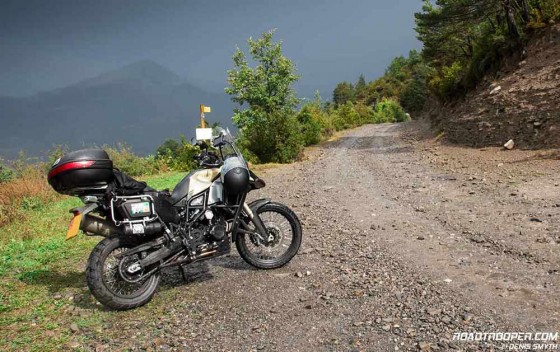
One of the glorious gravel roads in the Pyrenees Ordesa y Monte Perdido National Park
The Benefits of Tubeless Tyres
The argument for the cast wheel is easy. While utterly inflexible modern cast rims are very strong, it would take a hell of a pothole to crack one. The BMW 1200GS for example has cast wheels and plenty of folks happily ride it into the dirt with no problems. The main point however is that they can hold a tubeless tyre which are “usually” easily and quickly fixable with a plug kit. More often than not you’re on your way in 10 minutes making them the best choice for a road bike. Technically I should point out that a plugged tyre is a compromised tyre, not safe for high speeds and should be replaced asap. But the point is you’re on your way.
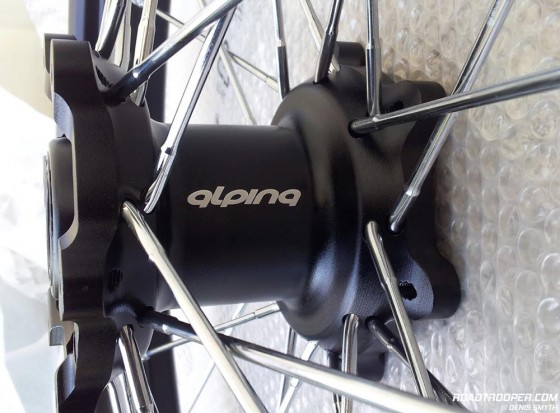
Nice and neat, Alpina wheels are not over branded with their logos..
The other benefit to tubed tyres is the safety aspect. Due to the nature of the design a tubed tyre can deflate frighteningly quickly. This once happened to me on a Kawasaki VN800A, one second all was good in my world, the next my back tyre was flapping around like a spastic fish! Luckily I was only doing 30km/h at the time and I was able to pull over and stop safely. If I’d been doing 60 round a bend, well you know yourself what would be the likely outcome to that. Yes, I know, a puncture on a tubed tyre does not always mean it’s sure to explode. But with tubeless tyres an explosive release of air pressure less likely “by far” for the average/typical puncture.
It’s simply in the nature of the design that you can ride for miles with a nail embedded in a tubeless tyre before you realise the tyre feels a bit soft. After my exploding back tyre incident I never really felt relaxed on my VN which I eventually sold and replaced with a R1150RT which coinsidently got a puncture 3 weeks later. However I only realised I had a puncture on the RT when a mate noticed a big assed nail in the rear tyre during a rideout’s coffee stop tyre kicking session. This experience forever confirmed my belief that tubeless is far better for primarily road riders like myself.
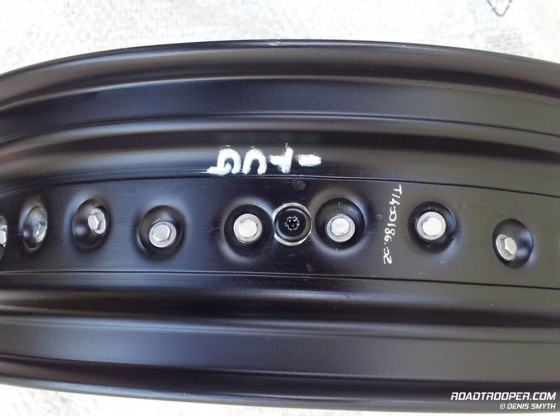
Alpina STS – Standard Tubeless System
On more than one of the adv bike forums I regularly browse the hard core adv riders often seem to get very defensive with others who express the down sides to tubed tyres and spoked wheels. Don’t be a pussy, always carry a full tool kit, a spare tube and learn to fix a flat yourself being a typical comment.
Most adv bike riders like myself spend at least 90-95% of their annual mileage on paved roads and would logically choose a 90/10 road biased tyre as that is where we predominantly spend our time. Using this logic why would I not want a road biased wheel?
The F800GS is pitched as an off road bike and would therefore be logically better suited to wear a spoked wheel. Except for the 90% of riders who might never venture off road and might choose the F800GS for any number of reasons with it’s off road ability being at the bottom of their priority list. BMW knows this, which is why we get the BMW patented cross-spoked tubeless wheel on the 1200GSA and cast wheels strong enough for trail rides the average and novice rider might take on.
In 2013 I bought the F800GS Adventure Touring Edition as for me it’s the perfect choice for touring Europe, it ticks all the boxes I currently require from a motorbike. The BMW 1200GSA was also considered but I could not afford it, nor did I fancy it’s size and weight. The F800GSA comes with exactly the same wheels as the standard F800GS with no option for a tubeless rim. Some folk rig up a patch and sealant system to plug the holes on a spoked rim and there are also kits available for this. But the problem with this is it might let you and your tyre down, and more importantly – it will almost certainly invalidate your insurance for road use!
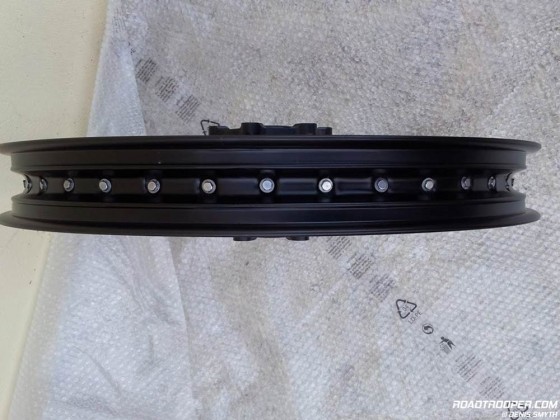
Alpina STS – Standard Tubeless System
What is STS (Standard Tubeless System)
STS (Standard Tubeless System) is a patent based on the application of a very specific O-Ring nipple design and from my understanding this is where the magic lies. Therefore, on some bikes not only can you use your original hubs, you can also use the same rims (ANY BRAND BUT SPECIALLY DRILLED) according to ALPINA RAGGI specifications and TOLERANCES. So if you can lace up a wheel yourself or can get your local mechanic to do the work it’s not overly expensive. My understanding of this is that you may only need to replace your nipples. I chose to buy the whole wheelset so I could simply and quickly swap the wheels between my 800GSA (primarily my touring bike) and 800GS (primarily my dirt/trail bike) as and when I needed.
Not that I had a choice with the F800GSA. Currently the Alpina STS Conversion Kit is not available for the BMW or Ducati bikes as Alpina want the wheels for these models to be available in Germany who have strict TUV laws. The STS kit at the minute is only available for Triumph, KTM road bikes + all MX and supermoto models, but this may change as this article gets older so check with your dealer.
How does the Alpina Tubeless System work?
From what I understand the holes in the rim that the spokes would normally pass through are now threaded, and a small “terminal/nipple” is installed into each hole – complete with a gasket “O-Ring” to prevent air from leaking out around the terminal. Each spoke is then connected to one of the terminals, joining the rim and the hub. For a far more technical explanation you can download a .PDF of the system here.
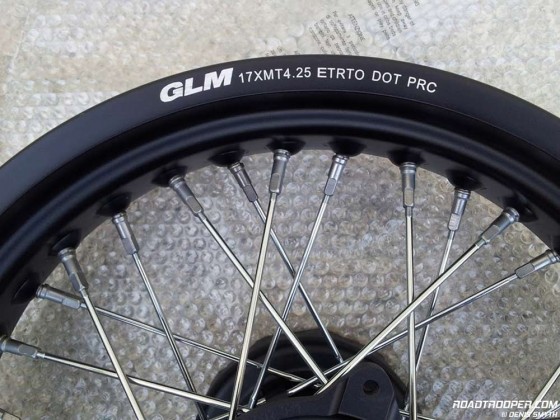
Alpina STS – Standard Tubeless System
The sprung mass of a motorcycle is that part of the machine which sits on top of the suspension, or in other words, the part of the bike which moves up and down if you sit on it and bounce on the seat. The unsprung mass is everything that does not move up and down! In effect, the unsprung mass of every bike consists of tyres, wheels, brake discs and calipers, rear sprocket, lower part of the front forks, and the swingarm. It is generally recognised that road holding characteristics are enhanced by reducing a machine’s unsprung mass. For example, when a wheel goes over a bump in the road, a lower unsprung mass will allow the suspension system to respond to the shock more quickly and effectively, meaning that the tyre is more able to stay in contact with the road surface.
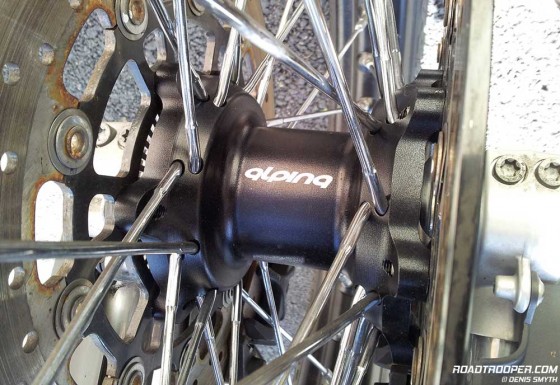
Depending on your bike much of this unsprung weight loss which equates to less gyroscopic force, more specifically at the front wheel will be felt on the handlebars in the form of lighter steering and a quicker turn-in. If you think about it the tube for my front tyre tube alone weighs half a kilo. This weight grows exponentially the faster the wheel spins as the laws of rotating mass dictate.
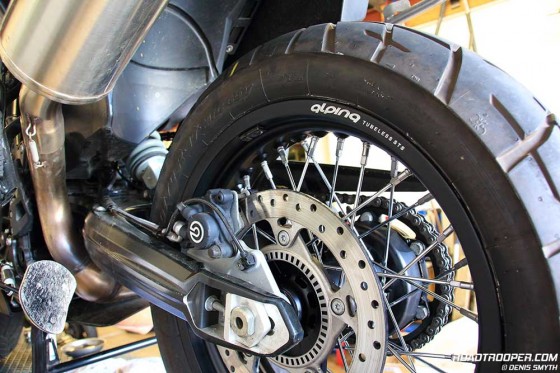
Looks good to me..
The majority of the advantage of reducing rotating mass in the wheels is achieved by reductions at the perimeter (rim and tire). Weight lost in the hubs would have the least impact being closest to the center and having little gyroscopic force. Less rotating mass on the outside of the wheels results in lighter faster steering, quicker turn-in and a generally more nimble machine. With less weight at the wheel the less force it also takes to get spinning so better fuel economy and acceleration, plus less force needed to stop the spin and therefore better braking.
Now for the compromise I mentioned. It should be noted that there is an important balance to be made with unsprung weight. Less unsprung wheel weight = less gyroscopic force also = less stability as it’s gyroscopic force that keeps a bike upright, i.e. if the wheels stop spinning the bikes falls over. Unsprung weight also has a direct effect on comfort too. Cruiser bikes or the likes of the PAN or RT have far more unsprung weight than a sports bike. A combination of a higher unsprung weight and fatter, high profile tyres will result in less aggressive vertical acceleration being experienced by the rider’s body as the machine passes over bumps, giving a more luxurious ride. It also helps lower the center of gravity of big heavy machines like the RT making it feel balanced and composed at all speeds.
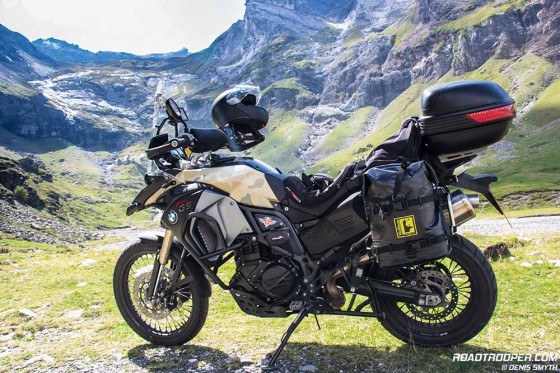
Apart from a tool kit and a few essentials be ruthless when packing. The less weight the better on any type of motorcycle trip..
The ”total” weight loss of 4kg’s however is a different matter entirely and this is where my interest really lies. When touring, any weight loss is good as every bit I bolt onto the bike, or remove from the luggage rapidly adds up. A weight loss on this scale (4kg) has major benefits to an already heavy bike when I do take it off the road. On a 90/10 mixed riding tour the weight benefits are a no-brainer for me and in fact has become an obsession. In the last few years I’ve managed to cut my typical “2-week tour” luggage weight by a staggering 25kg which makes a massive difference when venturing off the tarmac. When I then take into account the on-road safety aspect and potential ease of a puncture repair far from home the benefits are undoubtedly apparent for me. On top of that, if I’m leading a tour group it’s essential for me not to be the one delaying the group unnecessarily.
Strength?
Supposedly the Alpina wheelset is also stronger than my standard set. Now thats not something that I’m realistically going to put to the test and I’m not planning a ride along Russia’s brutal BAM trail into Siberia anytime soon. And as stated before, it takes a hell of a bang to damage a modern rim and it’s very unlikely to happen. But it’s good to know as my limited experience off road regularly sees me mess things up. I’ll be back trail riding in Spain from April so I’ll update this article with any developments on this front.
How good do they look?
Cosmetically the Alpinas look the business as like many I love the look of spoked wheels. I also prefer how Alpina have managed to keep the look of the traditional spoked style where the spokes enter the rim at the center unlike what BMW have done on the 1200GSA where the cross-spokes seem weird splayed out along the rims edge. Alpina offer an astonishingly array of colors for their wheels and you can mix and match the color of the hub, rim and spokes. However I chose the mat black for the hub and rim with nice shiny chrome for my wheelset. I’m not really the flashy type and would prefer potential thieves not to have a reason to be taking too close a look at my gear.
Problems?
The only negative thing I’d have to say about the Alpina wheels is about the chrome on the spokes. They have already started to rust and pit slightly, more so on the front as the rear usually gets covered in chain oil which I guess protects ‘em. I’ve since started lightly coating the spokes with Corrosion Block High Performance Grease, carefully avoiding the brake disks of course which so far seems to have fixed the issue. If it continues I’ll order a set of black colored spokes. As far as potential problems go it’s a minor one, just a little disappointing as I rarely bother cleaning the spokes on my 2009 F800GS with the standard BMW wheels, but when I do they look as new.
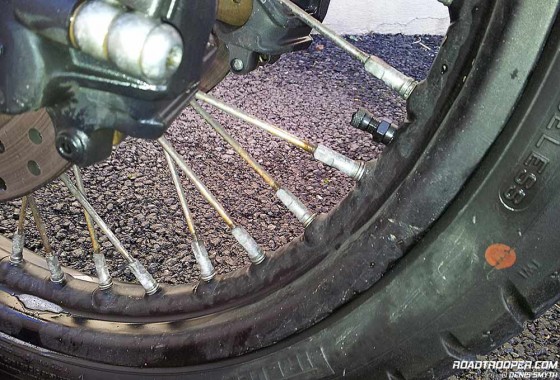
With the chrome spoke option ye need to keep a close eye on ‘em that rust does not set in..
Can I get a set for my bike?
Alpina make STS wheels and kits for a wide range of models for the following manufacturers, BMW, KTM, Triumph, and Ducati. I believe they have a new range of products for 2015. Find out more here: http://www.alpinaraggi.it/ or contact a dealer.
Where to buy?
I got my Alpina set from Alpina UK who were excellent in answering my endless questions before I made my order. Obviously they can’t carry the stock for every model but as promised my wheels arrived within 5 weeks, was really well packaged and good contact remained throughout the process.
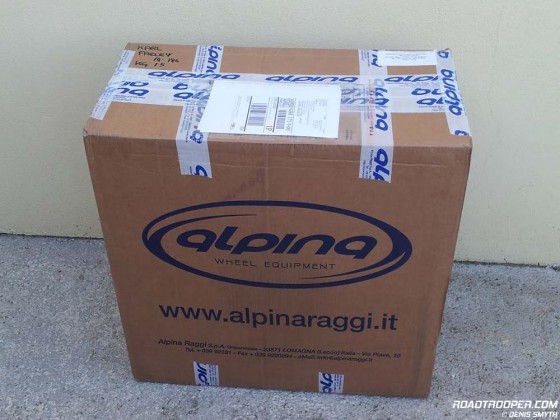
Ripping open a box of goodies is always fun ![]()
Conclusion?
I’m very happy indeed and for me it was worth the investment and thats all that matters ![]() If you fancy swapping from tubed to tubeless I’d certainly recommend considering the Alpina STS options and having a chat with Karl at Alpina UK about it.
If you fancy swapping from tubed to tubeless I’d certainly recommend considering the Alpina STS options and having a chat with Karl at Alpina UK about it.
More Information:
Alpina UK, Email: racing-carbon at sky dot com
Alpina Raggi SPA
Aplina STS: Standard Tubeless System Specification
O-Ring for Tubeless System Aplina-STS
About Alpina Raggi SPA
Alpina Raggi SPA was founded by Guido Cappellotto in 1926 in Laorca (Lecco), as an Italian factory of spokes and nipples for bicycles and motorcycles. In 2005, Alpina patented the tubeless system which then passed all laboratory tests of homologation and long-distance tests imposed by the specifications of motorbike manufacturers. The ALPINA -STS system was marketed in the AFTERMARKET as from 2007.
Some products (BMW R1200GS – BMW F800GS) are provided with TUV type-testing. The ALPINA-STS system is used in motorcycle racing (Cross World Championship – Super Motard)
by individuals and TEAM FACTORY directly followed by ALPINA since 2006 The Alpina STS System has equipped 10 Supermoto World Championships since 2006.
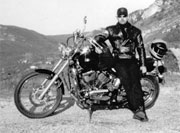







Interesting article.
Have you had experience with tyre sealants (aka”gloop”)?
Allegedly some types are suitable for use with tubed tyres.
I’ve never used gloop or similar as it’s a bit of a gimmick which may or may not work and if you don’t install it correctly you can easily mess up your valve. You may also get into trouble if you accidently over inflate your tire as Gloop may block the valve as it’s supposed to. It can also lead to other problems like negatively affecting the weight of the tyre (affecting turn-in etc) and decreasing the tires lifetime. It can also unbalance the wheel, so after installing it you need to check and may re-balance the wheel. Either way before using it it’s always best to talk to your dealer about it first. I’ve talked to 3 dealers about using it on various bike models and tires and I was always advised not to use it for various reasons.
On top of that, if the tire manufacturer does not advise its use then your insurance company will likely use this to invalidate your insurance and refuse to pay out if you make a claim. So, if you do choose to use it I’d definitely advise talking to your dealer AND a mechanic who knows the specifics of your bike and tire. And without doubt you should let your insurance company know you are using it and make sure your policy remains valid, it’s best to get this in writing as most insurance companies are a bunch of tossers who will use any excuse not to pay out in the event of a claim. As far as I am aware, Gloop etc is not TUV approved which technically makes your tire illegal for road use in some countries like Germany and this is where your insurance company “may” legally have a get out of payment clause.
I talked to a motorbike insurance broker mate about this a few years back. At that time it was his opinion Gloop and similar products were considered a “modification that can cause a change to a motorcycle’s handling characteristics”. And unless such products have EU safety test approval than he would decline any claim made where such a modification was in place when/if an accident occurred. This is of course is a technicality and i’ve never heard of Gloop being in any way the cause of an accident and it has thousands of happy customers who have used it without issue. All I’m saying here is that your insurance company won’t care that it usually works and for me using it is not worth the risk or potential hassle and expense. I asked my insurance company about using Gloop when I got my 1st 800GS and they could not give me a straight answer which is one of the reasons I decided to play it safe and just buy the tubeless wheels so at least I know I’m insured.
Hope this helps..
D
Thanks! I used it in a wheelbarrow tyre once….
I bought a BMW F650GS (single) and the previous owner swore by the stuff – I was not convinced especially with inner tubes.
On another note, I enjoyed reading your Anakee 3 Tyre review (which I can’t find at the moment). I have just bought a set of Tourance Next tyres for my R1200GS having read this comparative review in a German magazine (Google translate is handy here!). I hope I did not make an expensive mistake! I previously used standard Tourances which when squared off gave confidence sapping handling after only about 3-4,000 miles.
All the best, Nick
PS
Here is the reference:
http://www.motorradonline.de/motorradreifen/enduroreifen-im-reifentest-2013-metzeler-tourance-next-testsieger/454797?seite=12
Hi Nick,
You’ll find the Anakee 3 review in the review section, here’s the link Anakee 3 review
I’m sure you’ll be fine with the Tourance Next on the 1200GS, countless punters love ‘em while many complain of noise with the Anakee 3′s on the big GS. It does not really matter a whole lot what you choose as long as they suit your riding style and you feel confident on them as thats the most important bit.
Safe riding,,
D